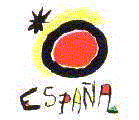
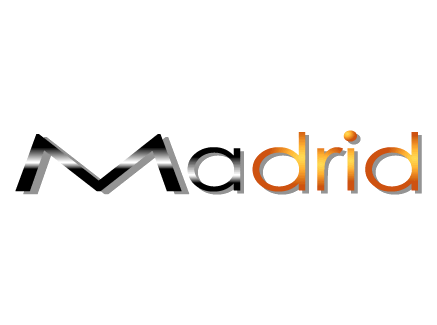
Part 1
Thursday 6 April 2000
Our journey to Madrid is everything but smooth. When we get on the train in Rotterdam for the airport an announcement comes through saying that the train has some mechanical problems and we will be delayed for an unknown amount of time. The problem is solved within ten minutes. When we aproach Leiden another anouncement gets us really worried. The tracks between Leiden and the airport are blocked and our train will make a detour via Sloterdijk. The train runs slower and slower and at Sloterdijk our next connecting train to Schiphol airport will be leaving at 11:20am, exactly the ultimate time for checking in at the airport. What do we do? We grab a taxi and urge the drive to "step on it". At 11:19 we arrive at the check-in desk. In the nick of time. But the flight is overbooked and we have to wait and see whether we will be allowed to board it. Well we were not. We (plus a dozen of Ecuadoranians) have to wait for the next flight of 4:30pm. As virtually noone of the KLM ground staff speaks Spanish and the Ecuadoranians nothing but Spanish, I soon find myself in the role of unpaid interpreter for the poor Ecuadoranians. We get 325 guilders as compensation in cash plus a meal and drinks. The 4:30 flight goes as planned, but when we arrive in Madrid it appears that our baggage will be on the next flight. That is another four hours later. We decide to go to our hotel and come back for the suitcases later. All in all it is not until 11:30pm when have everything in order. As if nothing happened we make for a nearby bar for a well deserved beer and tapas.
Friday 7 April 2000
Today is a sunny day and temperatures will go up to around 20 degrees
Celcius.
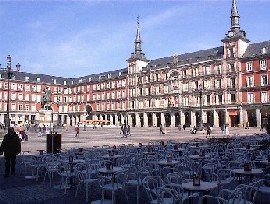 After
breakfast we take the metro to Puerta del Sol square, a central square in
Madrid. All distances in Spain to the capital are measured from here. A special
stone marks kilometer "zero". From here we walk to the Plaza Mayor, a
grand square in the old town. We head for a side walk café and enjoy a coffee
inthe morning sun. The plaza is a brain child of king Felipe II, who wanted a
grander centre for his new Spanish capital. The oldest building is at the North
side of the square, Casa de la Panderia, the former guild house for the bakers
and dates back to 1590. The work on the square really got underway during Felipe
III 's reign and was finished in 1619. The equestrian statue in the middle
represents Felipe III. The square was used in the next centuries for state
occasions, executions an
After
breakfast we take the metro to Puerta del Sol square, a central square in
Madrid. All distances in Spain to the capital are measured from here. A special
stone marks kilometer "zero". From here we walk to the Plaza Mayor, a
grand square in the old town. We head for a side walk café and enjoy a coffee
inthe morning sun. The plaza is a brain child of king Felipe II, who wanted a
grander centre for his new Spanish capital. The oldest building is at the North
side of the square, Casa de la Panderia, the former guild house for the bakers
and dates back to 1590. The work on the square really got underway during Felipe
III 's reign and was finished in 1619. The equestrian statue in the middle
represents Felipe III. The square was used in the next centuries for state
occasions, executions an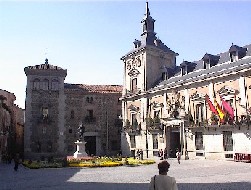 d
bull fights. Nowadays it is a tourist haunt. From the Plaza Mayor we walk
to the Plaza de la Villa, the oldest square of Madrid. It originally was the
moorish market of medieval Madrid. The square is surrounded by a number of
buildings from the 15th, 16th and 17th centuries. Our walk continues through
narrow streets of the old town. WE also pass one of the loveliest squares in old
Madrid, Plaza de la Paja. It is a sloped square with dozens of acacias. Once the
hub of the town before the Plaza Mayor was built, now it's an oasis of silence
in a bustling city. On the south side of it is the Iglesia San
d
bull fights. Nowadays it is a tourist haunt. From the Plaza Mayor we walk
to the Plaza de la Villa, the oldest square of Madrid. It originally was the
moorish market of medieval Madrid. The square is surrounded by a number of
buildings from the 15th, 16th and 17th centuries. Our walk continues through
narrow streets of the old town. WE also pass one of the loveliest squares in old
Madrid, Plaza de la Paja. It is a sloped square with dozens of acacias. Once the
hub of the town before the Plaza Mayor was built, now it's an oasis of silence
in a bustling city. On the south side of it is the Iglesia San
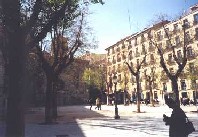 Andres,
a church badly damaged during the civil war, but now restored an reopened.
Through this square and some narrow streets of the former Morería (moorish
quarter) we reach Plaza San Andres, where we see a great looking
trompe
d'oeil painted on a
Andres,
a church badly damaged during the civil war, but now restored an reopened.
Through this square and some narrow streets of the former Morería (moorish
quarter) we reach Plaza San Andres, where we see a great looking
trompe
d'oeil painted on a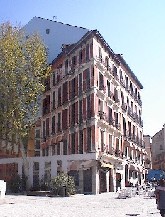 blind wall. The square is littered with side walk café's and tapas bars.
Through the Cava Alta and Cava baja streets we get back to the Plaza Mayor. It
is time for lunch and we find it near the Opera and the Royal Palace in a nice
bar cum restaurant (Taberna del Alabardero), where we eat a number of delicious
snacks (tapas). We take a look at the royal palace (from the outside). The view
from the palace square over the Campo del Moro and beyond is blocked by
archeological excavation works.
blind wall. The square is littered with side walk café's and tapas bars.
Through the Cava Alta and Cava baja streets we get back to the Plaza Mayor. It
is time for lunch and we find it near the Opera and the Royal Palace in a nice
bar cum restaurant (Taberna del Alabardero), where we eat a number of delicious
snacks (tapas). We take a look at the royal palace (from the outside). The view
from the palace square over the Campo del Moro and beyond is blocked by
archeological excavation works.
We take the metro to the Prado
museum, where we spend a good deal of the afternoon. The museum is well stocked
with Spanish mastrer of the 15th, 16th, 17th and 18th centuries. We limit
ourselves to the most important ones like Velazquez, El Greco and Goya. There
also many works of Rubens, Brueghel and other Flemish masters. We stop for a
while at Las Meninas, Velazquez' masterpiece. But also Goya's
Second
and Third of May (depicting the cruelties during the spanish rising against
Napoleon) are very impressive.
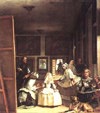 The
museum takes its toll. We're pretty exhausted and take a rest in the Cafe
Figueroa in the Chueca quarter for a drink. After that we retreat to our hotel
room for a rest.
The
museum takes its toll. We're pretty exhausted and take a rest in the Cafe
Figueroa in the Chueca quarter for a drink. After that we retreat to our hotel
room for a rest.
At night we first sample some tapas at Chipén in the Bilbao quarter (lovely cheese, anchoa and salmon on a slice of bread) and head for the Chueca quarter where have dinner (Brazilian this time). Chueca is also the epicentre of Madrid's extensive and lively gay scene. During the rest of the evening we get our first taste of that. When we return to our hotel it turns out that the square in front of it (Plaza de Santa Barbara) is the haunt of Madrid teenage population. It is not going to be a quiet night.....
Saturday 8 April 2000
Today is a rainy day. Unperturbed we start another walk. We start at the
monastery De Las Descalzas Reales (barefoot royal ladies). We visit the
monastery led by a guide who tells us in very fast Spanish what is there to be
seen. The monastery was founded by Juana of Austria, daughter of Carlos V,
sister of Felipe II and at 19 years old already widowed by Juan of Portugal.
Before the building became a nunnery in 1564 it was the residence of Carlos V's
treasurer. The nuns originally came from Gandía, near Valencia, but were soon
joined by royal wall flowers and widows, who upon entering the community took
there worldly possessions with them.
 The valuables (and they are many) are now on display. Up until present day still
26 shoeless Franciscan nuns still live here. After the visit it is still raining
and we head for the neighbouring department store of El Corte Ingles. We do some
serious shopping and have lunch in its cafeteria. After that we continue our
walk along the wide 19th century boulevards of Madrid: Calle de Arenal, Calle de
Alcalá en Gran Via. On the corner of the latter two is the characteristic
office block Metropolis from 1911 of the French architects Fevrier. Further on
is the Plaza de las Cibeles, a busy roundabout with a fountain an a number of
overstated official buildings like the Royal Mail's head office.
The valuables (and they are many) are now on display. Up until present day still
26 shoeless Franciscan nuns still live here. After the visit it is still raining
and we head for the neighbouring department store of El Corte Ingles. We do some
serious shopping and have lunch in its cafeteria. After that we continue our
walk along the wide 19th century boulevards of Madrid: Calle de Arenal, Calle de
Alcalá en Gran Via. On the corner of the latter two is the characteristic
office block Metropolis from 1911 of the French architects Fevrier. Further on
is the Plaza de las Cibeles, a busy roundabout with a fountain an a number of
overstated official buildings like the Royal Mail's head office.
When we have finished Gran Via until Plaza de España, we take the metro to the Salamanca quarter, a wealthy area with lots of designer fashion stores. The miserable weather though, spoils the fun of window shopping and we decide to give it a miss. We take the metro to the Chueca and sit down at the XXX-cafe, for an afternoon beer and wine.
At night we go to Taberna de Dolores, a popular, busy and friendly tapas bar in the Lavapies quarter. Delicious canapés (slices of white bread with delightful toppings) and a beer. We had the idea of eating at one of the recommended restaurants around here. But it is saturday night and we have no reservations. That is asking for trouble. After three or four "No, lo siento" (no we're sorry) we let our ambitions go and make do with a very simple eatery. After dinner we walk back to the Chueca for another night out.